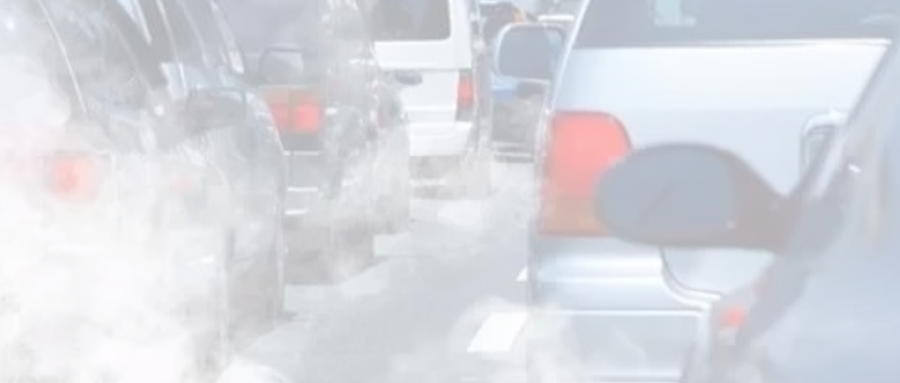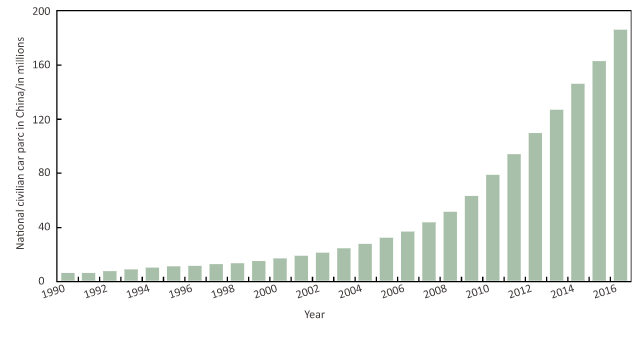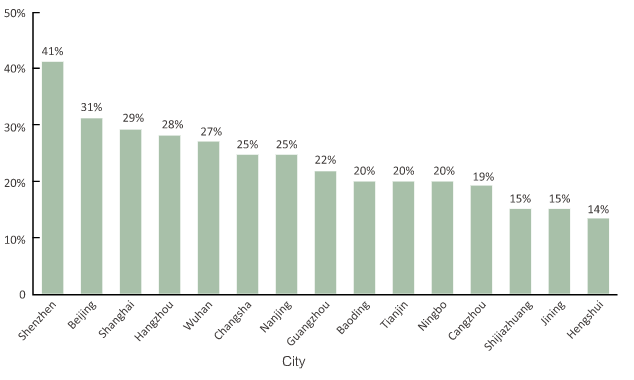
With the rapid development of China's industrialization and urbanization, the increasing energy demand has led to a significant increase in fossil fuel consumption in recent years. Air pollution caused by pollutant emissions has become one of the most serious environmental problems in China at the present stage. With the rapid growth of vehicle parc, motor vehicle pollutant emissions remain high, seriously impeding the continuous improvement of atmospheric environment quality. This is becoming an important environmental issue in China's urban economic and social development, to which relevant departments and the public have attached great attention and importance. Effective control of traffic pollution has become one of the key influencing factors to improve urban ambient air quality and protect public health. In recent years, identifying and controlling the impact and contribution of traffic pollution on urban air quality so as to cost-effectively control and reduce vehicle pollutant emissions and further improve urban air quality has become one of the pressing issues that need to be resolved by relevant departments and scholars of China. The study on traffic pollution characteristics and population health effects is of great public health significance for preventing and reducing the harm of air pollutants to public health.
Status quo of traffic-related air pollution
From 1990 to 2016, the national civilian car parc increased from 5.514 million to 185.755 million (Figure 1), an increase of 33 times in 27 years.
Figure 1: National civilian car parc from 1990 to 2016 1

With the rapid growth of motor vehicle parc, the emission of pollutants from motor vehicles remains high, and its impact on the urban ambient air quality is increasing. The gaseous pollutants emitted by motor vehicle exhaust, in addition to conventional pollutants, such as CO, HC, NOx and PM, generate a highly oxidative photochemical smog (secondary pollutants), including ozone (O3), secondary PM2.5, etc. through a series of complex photochemical reactions in the atmosphere. More and more China's urban air quality being transformed from traditional coal-fired pollution to composite pollution combining coal-burning, vehicle exhaust and secondary pollutants2, which seriously affects the health and life quality of the exposed population.
Figure 2: Contribution of motor vehicles to PM2.5 concentration in urban atmospheric environment (%)

Although the contribution of PM2.5 concentration in most cities is still dominated by coal-fired emissions, the contribution of mobile sources to atmospheric PM2.5 in first-tier cities such as Beijing and Shanghai and densely populated areas in the central and eastern regions has reached 20% to 45%. As shown in Figure 2, the local pollution contribution of Beijing and Shanghai is about 30%, which exceeds that of coal and industrial production and becomes the largest PM2.5 contributor in the local atmospheric environment. Moreover, since most of motor vehicles are driven in densely populated areas of the city, the pollutants emitted from the exhaust are mainly spread by mechanical diffusion and hot turbulent diffusion in the vicinity of the human respiratory zone, so that the concentration of pollutants in traffic micro-environment, e.g. in the vehicles and on both sides of the road, is much higher than the environmental background concentration. This significantly increases the actual exposure level of pollutants to the population, and also the health risks of the exposed population. In this case, the control of traffic-sourced pollution is becoming the most prominent and urgent problem in the urban air pollution control and disease prevention & control in China.
Main health effects of traffic-related air pollutants
As mentioned above, traffic-related air pollutants include conventional pollutants, such as CO, HC, NOx, and PM, and secondary pollutants, such as ozone (O3) and secondary PM2.5. Their pollution and health hazards are characterized as follows: I. The pollutants are diffused in a way of linear source emission, that is, the level of pollutants is high on both sides of urban and rural traffic trunks or highways, and gradually decreases along their peripheries; II. The pollution involves complicated composition, i.e. there are not only direct pollutants, but also a large number of secondary pollutants which are gradually formed in the atmosphere; III. The pollutants are discharged close to the human respiratory zone, resulting in more direct and rapid health hazards to the exposed population. Its main health effects include:
Effect on the respiratory system
Because the emission of traffic-related air pollutants is highly close to the human respiratory zone, it is more straightly harmful to the human respiratory system. The exposed population is generally occupational groups closely related to transport, such as traffic police, bus drivers and sales staff, highway toll collectors, field station guards and attendants. These groups are subject to long-time exposure to the traffic environment due to occupational characteristics. The health effects on their respiratory systems cannot be ignored. Researches in Shanghai, Hong Kong and other places in China have shown that the incidence of respiratory symptoms such as cough, sore throat and pharyngitis in motorists has increased significantly3,4, indicating that long-term exposure to traffic pollutants reduces the respiratory resistance and functionality of occupationally exposed people. Children are susceptible to traffic exposure. Many studies have shown that traffic pollution exposure may have many adverse effects on children's respiratory system, causing increased incidence of respiratory symptoms such as asthma, wheezing, and increased airway responsiveness in children living near high traffic flow5, 6.
Effect on cardiovascular system
The cardiovascular diseases associated with traffic-related air pollution mainly include myocardial infarction, coronary heart disease, hypertension and ischemic heart diseases7-9. A cohort study in Vancouver, Canada, conducted a four-year follow-up of 452,735 residents aged 45 to 85 years without coronary heart disease to assess the exposure concentrations of traffic-related pollutants, such as PM2.5, black carbon (BC), and NO2, and the coronary heart disease-related admission and mortality of the subjects during the follow-up period. It showed that for every 0.8 μg/m3 increase in BC concentration, the admission rate of coronary heart disease increased by 3% and the mortality rate increased by 6%, demonstrating statistical significance and a linear exposure-response relationship. A group study conducted in Beijing taken a group of healthy young students as subjects to follow up and observe changes in exposure levels of air pollutants before and after their relocation from suburban campuses to urban campuses and the impact of such changes on the cardiovascular system. The monitoring data showed that the PM2.5 concentration of urban areas was lower than that of the suburbs, while the levels of carbon components and gaseous pollutants in urban PM2.5 were significantly higher than those in the suburbs, indicating that traffic emissions have a greater impact on the composition of urban air pollutants. After the population moved from the suburbs to the urban areas, the inflammatory biomarkers and homocysteine levels in blood generally showed a rising trend, and coagulation biomarkers tended to decrease in general. These suggest that traffic sourced components of PM2.5 may be an important factor leading to the above changes10.
Effect on the nervous system
In recent years, the impact of traffic pollution on the neurobehavior of exposed population has gradually attracted the attention of researchers. Current researches suggest that exposure to traffic-related air pollutants can cause neurological function impairment in children such as cognitive impairment. Studies have shown that traffic-related air pollution exposure is significantly proportional associated with decreased neurobehavioral function. A study of the correlation between exposure to traffic pollution and children's neurobehavioral functions11 carried out in Quanzhou determined the neurobehavioral functions of pupils from schools in traffic-contaminated area and clean control area, the average concentrations of NO2 in which are 36μg/m3 and 7μg/m3 respectively. The analysis results showed that all neurobehavioral function indexes of the pupils from the traffic-contaminated area are lower than those from the clean control area. In addition, a study conducted in Germany analyzed the association between cognitive dysfunction of 399 elderly women living at the same address for more than 20 years and the concentration of traffic-related particulate matter in their living environment. The results showed significant association and an exposure-response relationship between traffic-related particulate matter exposure and the cognitive dysfunction of the subjects. Since cognitive dysfunction is a high risk factor for the progression of Alzheimer's disease, this study suggests that long-term exposure to traffic-related particulate matter may also be one of the causative factors of senile Alzheimer's disease12.
Carcinogenic effect
A large number of studies have confirmed that traffic-related air pollutants contain many carcinogens and mutagens, such as PM, polycyclic aromatic hydrocarbons (PAHs) and benzene, which can damage the body's genetic material and interfere with the normal division of cells, while destroy immune surveillance function of the body and cause mutations and cancers in human13. Reacting with the body, PM in the exhaust of motor vehicles can produce reactive oxygen species, leading to oxidative stress, inflammatory reaction and DNA damage, while the mutagenic effect of PAHs is related to the formation of PAH-DNA adducts in the body and the DNA strand breakage. In 2012, the International Agency for Research on Cancer (IARC) listed diesel exhaust as a definite human carcinogen, pointing out that diesel exhaust exposure can cause lung cancer and is also proportionally associated with the risk of bladder cancer.
Disease burden attributable to traffic-related pollutants
In recent years, domestic researches on the disease burden of the population exposed to traffic-related pollutants showed that 14 PM2.5 pollution caused by traffic-sourced emissions in 2010 may cause premature deaths of about 116,900, accounting for 9.31% of the overall health burden of PM2.5 (1,255,400 premature deaths). To this extent, the number of deaths from stroke was 63,100, 13,200 from chronic obstructive pulmonary disease, 9,800 from lung cancer, and 30,800 from ischemic heart disease, respectively accounting for 53.9%, 11.4%, 8.3%, and 26.4% of the national total number of premature deaths from the four traffic-sourced health outcomes of the year. Another study also showed that, as China's pollution caused by motor vehicle emissions shows an obvious regional characteristic, traffic-sourced health burden is not only associated with traffic pollution intensity, but also widely distributed in densely populated areas15. For example, in Shandong and Henan, the health burden of air pollution related to traffic-sourced emissions is heavier, mainly because the populations in Shandong and Henan are quite dense, resulting heavier health burden even though the contribution of traffic-sourced pollution does not take a large share.
Health benefits to people from controlling traffic-related pollution
In recent years, whether controlling the level of traffic pollution can improve people's health has received widespread attention from researchers. For example, during the Beijing 2008 Olympic Games, the Beijing Municipal Government took a series of traffic pollution control measures, including the introduction of new energy (natural gas) to replace coal, the development of public transport, the implementation of motor vehicle restrictions, and the prohibition of heavy trucks on the road during the day, the implementation of new motor vehicle emission standards, the elimination of old high-emission motor vehicles in Beijing, and controlling industrial and traffic pollution emissions from neighboring provinces and cities. These strict traffic control measures and policies produced obvious effects, making the concentration of traffic pollutants in Beijing, as well as the PM2.5 and BC concentrations of the 12 traffic arteries, during the Olympic Games significantly lower than that before the Olympic Game16. Taking this as an opportunity, researchers in China have discussed the health benefits to people from traffic pollution control in terms of health impact, health economic loss and cancer risk. A study with taxi drivers as the subjects17 discussed the relationship between the PM2.5 concentration change before, during and after the Olympic Games and the subjects’ HRV level. The result shows that increased traffic-sourced PM2.5 exposure concentration is significantly related to reduction in HRV levels. Since HRV level reflects the regulation function of the cardiac autonomic nervous system, the HRV level increased significantly during the Olympic Games is considered to be a manifestation of a reduction in the risk of cardiovascular disease. In this regard, the result suggests that decrease in the traffic-sourced PM2.5 concentration can reduce the risk of cardiovascular disease in a certain extent. In the same period, studies combined the methods of atmospheric diffusion model, epidemiology and environmental economics to evaluate the health effects and related economic losses caused by traffic pollution in Beijing from 2004 to 2008. The results showed that the traffic pollution-related incidence and related economic losses, e.g. acute and chronic bronchus, respiratory diseases and asthma attacks, increased to varying degrees between 2004 and 2007, but there was a certain degree of reduction in the 2008 Olympic Games, suggesting that the implementation of traffic pollution control policies has a positive effect on health improvement and can reduce economic losses due to health impact18. There is also a research showed that during the Olympic Games, the PAHs content in the atmosphere of Beijing was significantly lower than that during non-Olympic period, and the excess cancer risk corresponding to the PAHs content was significantly lower than that during non-Olympic period, suggesting taking effective measures to control traffic pollution sources can significantly reduce the cancer risk to people19. The above research results provide direct evidence for the improvement of the health of exposed population through the implementation of relevant policies and measures for traffic pollution control, and provide an important scientific basis for further implementation of traffic pollution control policies and measures for health protection.
Conclusion
China's traffic-related air pollution and its population health impact are increasingly prominent and are becoming pressing issues that need to be resolved by relevant departments and scholars of China. So far, considerable research experience and outcomes pertaining to health hazards of traffic pollution have accumulated domestically in terms of its diffusion mechanism, population health epidemiology, economic loss assessment and related technical measures for prevention and control. However, for the comparative study and investigation before and after the implementation of traffic pollution control policies and measures, there has not been systematic and comprehensive empirical research.
Reference:
1. China Bureau of Statistics. China Statistical Yearbook [M]. Beijing: China Statistics Press
2. 2017 Li Pei, Wang Xin, Chai Fahe, et al. Comprehensive management measures for urban air pollution control in China [J]. Environment and sustainable development, 2011, 36 (5): 8-14
3. Jones A Y, Lam P K, Dean E. Respiratory health of bus drivers in Hong Kong [J]. Int.Arch.Occup.Environ.Health., 2006,79:414-418.
4. Zhou W, Yuan D, Ye S, et al. Health effects of occupational exposures to vehicle emissions in Shanghai [J]. Int. J. Occup.Environ. Health.,2001,7:23-30.
5.Skrzypek M, Zejda J E, Kowalska M, et al. Effects of residential proximity to traffic on respiratory disorders in school children in upper Silesian Industrial Zone, Poland [J]. Int. J. Occup. Med.Environ. Health., 2013,26:83-91.
6.Andersson M, Modig L, Hedman L, et al. Heavy vehicle traffic is related to wheeze among schoolchildren: a population-based study in an area with low traffic flows [J]. Environ. Health.,2011,10:91.
7.Gan W Q, Koehoorn M, Davies H W, et al. Long-term exposure to traffic-related air pollution and the risk of coronary heart disease hospitalization and mortality [J]. Environ. Health. Perspect., 2011,119:501-507.
8.Cooqan P F, White L F, Jerrett M, et al. Air pollution and incidence of hypertension and diabetes mellitus in black women living in Los Angeles [J]. Circulation, 2012,125:767-772.
9.Beckerman B S, Jerrett M, Finkelstein M, et al. The association between chronic exposure to traffic-related air pollution and ischemic heart disease [J]. J. Toxicol. Environ. Health., 2012,75: 402-411.
10.Wu S, Deng F, Huang J, et al. Blood pressure changes and chemical constituents of particulate air pollution: Results from the healthy volunteer natural relocation (HVNR) study [J]. Environ. Health. Perspect., 2013,121:66-72.
11.Wang S, Zhang J, Zeng X, et al. Association of traffic-related air pollution with children’s neurobehavioral functions in Quanzhou, China [J]. Environ. Health. Perspect., 2009,117:1612-1618.
12.Ranft U, Schikowski T, Sugiri D, et al. Long-term exposure to traffic-related particulate matter impairs cognitive function in the elderly [J]. Environ. Res., 2009,109:1004-1011.
13.de Kok T M, Driece H A, Hogervorst J G, et al. Toxicological assessment of ambient and traffic-related particulate matter: A review of recent studies [J]. Mutat. Res., 2006,613:103-122.
14.XIE R, SABEL C E, LU X, et al. Long-term trend and spatial pattern of PM 2.5 induced premature mortality in China[J]. Environment international, 2016, 97: 180-186.
15.Wu Xiaomeng. Research on coordinated control strategy of air pollutants and CO 2 emissions from road vehicles in China [D]. Beijing: Tsinghua University, 2016
16.Wang X, Westerdahl D, Chen L C, et al. Evaluating the air quality impacts of the 2008 Beijing Olympic Games: On-road emission factors and black carbon profiles [J]. Atmos. Environ., 2009,43:4535-4543.
17.Wu S, Deng F, Niu J, et al. Association of heart rate variability in taxi drivers with marked changes of particulate air pollution in Beijing in 2008 [J]. Environ. Health. Perspect., 2010,118:87-91.
18.Guo X R, Cheng S Y, Chen D, et al. Estimation of economic costs of particulate air pollution from road transport in China [J]. Atmos. Environ., 2010,44:3369-3377.
19.Jia Y, Stone D, Wang W, et al. Estimated reduction in cancer risk due to PAH exposures if source control measures during the 2008 Beijing Olympic were sustained [J]. Environ. Health. Perspect., 2011,119:815-820.





